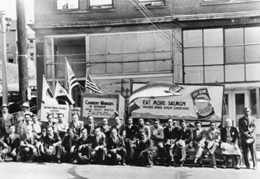As early as the 1920s, Filipinos from Seattle were contracted to work in Alaskan canneries. The canneries offered summer work for students to pay for their studies. In 1930, more than 4,000 of these "Alaskeros" worked in the canneries. Labor unions organized for the workers centered many of their activities in Seattle. In 1933, the Cannery Workers and Farm Laborers Union Local 18257 became the first Filipino-dominated cannery workers organization. Efforts at reform of contracting practices led to the assassinations of Filipino union organizers in the 1930s and 1980s.
A Turbulent History
Many abuses occurred. Contractors who hired workers for the canneries sometimes forced Alaskeros to provide a bribe in exchange for employment. The contractors sometimes organized and controlled gambling in order to get more money from workers. Cannery workers also lived in often crowded, segregated, substandard housing while on the job.
Union organizers fought against these practices and contractors fought back. In 1936, contractors had Virgil Duyungan, union local president, and Aurelio Simon, local secretary, assassinated outside a Japanese restaurant in Seattle. Before dying, Duyungan managed to shoot his assailant, killing him. After the assassination, the union continued to have a turbulent history and various affiliations. In 1949, union officers of Local 7 were arrested as "communists." Under U.S. law, communists were subject to deportation. Appealing their case, they resisted deportation on the grounds that they had entered the country as "nationals" not "aliens" before the status of Filipinos was changed in 1934. The U.S. Court of Appeals in San Francisco ruled in favor of the labor officers.
In 1981, Local 37 officers Silme Domingo and Gene Viernes were gunned down outside the union offices in downtown Seattle. They had been trying to reform the corrupt system of dispatching workers to Alaska canneries. Four men involved in the murders were sentenced to life in prison. The Committee for Justice for Domingo and Viernes also charged that Ferdinand Marcos, then leader of the government of the Philippines, paid for the murders due to the victims' anti-Marcos activities.

